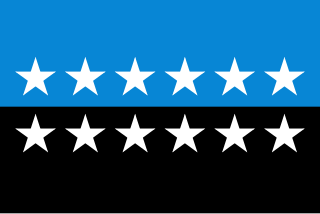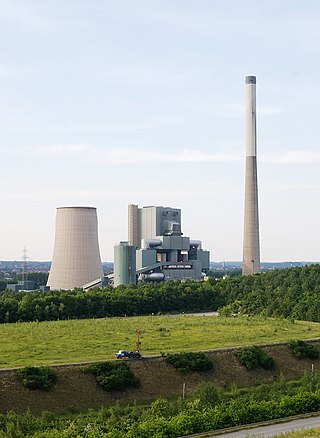Related Research Articles

The European Coal and Steel Community (ECSC) was a European organization created after World War II to regulate the coal and steel industries. It was formally established in 1951 by the Treaty of Paris, signed by Belgium, France, Italy, Luxembourg, the Netherlands, and West Germany. The ECSC was an international organization based on the principle of supranationalism, and started a process of integration which ultimately led to the creation of the European Union.

The Saarland is a state of Germany in the south west of the country. With an area of 2,570 km2 (990 sq mi) and population of 990,509 in 2018, it is the smallest German state in area apart from the city-states of Berlin, Bremen, and Hamburg, and the smallest in population apart from Bremen. Saarbrücken is the state capital and largest city; other cities include Neunkirchen and Saarlouis. Saarland is mainly surrounded by the department of Moselle in France to the west and south and the neighboring state of Rhineland-Palatinate in Germany to the north and east; it also shares a small border about 8 kilometres long with the canton of Remich in Luxembourg to the northwest.

The Ruhr, also referred to as the Ruhr area, sometimes Ruhr district, Ruhr region, or Ruhr valley, is a polycentric urban area in North Rhine-Westphalia, Germany. With a population density of 2,800/km2 and a population of over 5 million (2017), it is the largest urban area in Germany. It consists of several large cities bordered by the rivers Ruhr to the south, Rhine to the west, and Lippe to the north. In the southwest it borders the Bergisches Land. It is considered part of the larger Rhine-Ruhr metropolitan region of more than 10 million people, which is the third largest in Europe, behind only London and Paris.

Essen is the central and, after Dortmund, second-largest city of the Ruhr, the largest urban area in Germany. Its population of 579,432 makes it the fourth-largest city of North Rhine-Westphalia after Cologne, Düsseldorf and Dortmund, as well as the ninth-largest city of Germany. Essen lies in the larger Rhine-Ruhr Metropolitan Region and is part of the cultural area of Rhineland. Because of its central location in the Ruhr, Essen is often regarded as the Ruhr's "secret capital". Two rivers flow through the city: in the north, the Emscher, the Ruhr area's central river, and in the south, the Ruhr River, which is dammed in Essen to form the Lake Baldeney (Baldeneysee) and Lake Kettwig reservoirs. The central and northern boroughs of Essen historically belong to the Low German (Westphalian) language area, and the south of the city to the Low Franconian (Bergish) area.

The Sauerland is a rural, hilly area spreading across most of the south-eastern part of North Rhine-Westphalia, in parts heavily forested and, apart from the major valleys, sparsely inhabited.

The Bergisches Land is a low mountain range region within the state of North Rhine-Westphalia, Germany, east of Rhine river, south of the Ruhr. The landscape is shaped by woods, meadows, rivers and creeks and contains over 20 artificial lakes. Wuppertal is one of the biggest towns and seen as the region's capital, whereas the southern part nowadays has closer economic and socio-cultural ties to Cologne. Wuppertal and the neighbouring cities of Remscheid and Solingen form the Bergisches Städtedreieck.

The Rhine-Ruhr metropolitan region is the largest metropolitan region in Germany, with over ten million inhabitants. A polycentric conurbation with several major urban concentrations, the region covers an area of 7,110 square kilometres (2,750 sq mi), entirely within the federal state of North Rhine-Westphalia. The Rhine-Ruhr metropolitan region spreads from the Ruhr area (Dortmund-Bochum-Essen-Duisburg) in the north to the urban areas of the cities of Mönchengladbach, Düsseldorf, Wuppertal, Leverkusen, Cologne, and Bonn in the south. The location of the Rhine-Ruhr at the heart of the European Blue Banana makes it well connected to other major European cities and metropolitan areas such as the Randstad, the Flemish Diamond and the Frankfurt Rhine Main Region.

The Dawes Plan was a plan in 1924 that successfully resolved the issue of World War I reparations that Germany had to pay. It ended a crisis in European diplomacy following World War I and the Treaty of Versailles.

Mülheim, officially Mülheim an der Ruhr and also described as "City on the River", is a city in North Rhine-Westphalia in Germany. It is located in the Ruhr Area between Duisburg, Essen, Oberhausen and Ratingen. It is home to many companies, especially in the food industry, such as the Aldi Süd Company, the Harke Group and the Tengelmann Group.

The Occupation of the Ruhr was a period of military occupation of the Ruhr region of Germany by France and Belgium between 11 January 1923 and 25 August 1925.

Poles in Germany are the second largest Polish diaspora (Polonia) in the world and the biggest in Europe. Estimates of the number of Poles living in Germany vary from 2 million to about 3 million people living that might be of Polish descent. Their number has quickly decreased over the years, and according to the latest census, there are approximately 866.690 Poles in Germany. The main Polonia organisations in Germany are the Union of Poles in Germany and Congress of Polonia in Germany. Polish surnames are relatively common in Germany, especially in the Ruhr area.

Wattenscheid is a Stadtbezirk of the city of Bochum. Until 1975, it was a separate town in the Ruhr area of North Rhine-Westphalia. Wattenscheid has a population of about 80,000 citizens. Some notable firms have their headquarters in there, such as Steilmann.

Westerholt Power Station was a coal fired power station in Gelsenkirchen-Westerholt, Germany. The power plant consisted of two units built in the 1960s, each capable of producing 150 MW of electricity. Its smokestack, built in 1981, was 337 metres tall, making it Germany's tallest chimney at the time.

TU Dortmund University is a technical university in Dortmund, North Rhine-Westphalia, Germany with over 35,000 students, and over 6,000 staff including 300 professors, offering around 80 Bachelor's and master's degree programs. It is situated in the Ruhr area, the fourth largest urban area in Europe. The university is highly ranked in terms of its research performance in the areas of physics, electrical engineering, chemistry and economics. The university pioneered the Internet in Germany, and contributed to machine learning.

Bergkamen Power Station is a coal-fired power station in Germany. It is located in the city of Bergkamen, in the Unna district. It was established in 1981 and has an output capacity of 747 megawatts. The power station produces 4.8 billion kWh of electricity annually, and also provides long-distance heating through steam generation.

The year 1948 marked the beginning of the institutionalised modern European integration. With the start of the Cold War, the Treaty of Brussels was signed in 1948 establishing the Western Union (WU) as the first organisation. In the same year, the International Authority for the Ruhr and the Organization for European Economic Co-operation, the predecessor of the OECD, were also founded, followed in 1949 by the Council of Europe, and in 1951 by the European Coal and Steel Community, with the ensuing moves to create further communities leading to the Treaty of Rome (1957)

The Zollverein Coal Mine Industrial Complex is a large former industrial site in the city of Essen, North Rhine-Westphalia, Germany. The first coal mine on the premises was founded in 1847, and mining activities took place from 1851 until December 23, 1986. For decades, starting in the late 1950s, the two parts of the site, Zollverein Coal Mine and Zollverein Coking Plant, ranked among the largest of their kinds in Europe. Shaft 12, built in the New Objectivity style, was opened in 1932 and is considered an architectural and technical masterpiece, earning it a reputation as the "most beautiful coal mine in the world".

RAG AG, formerly Ruhrkohle AG, is the largest German coal mining corporation. The company headquarters are in Essen in the Ruhr area. The company was founded on 27 November 1968, consolidating several coalmining corporations into the Ruhrkohle AG.

The International Authority for the Ruhr (IAR) was an international body established in 1949 by the Western Allies to regulate the coal and steel industries of the Ruhr area in West Germany. Its seat was in Düsseldorf.

The Ruhr Valley Railway is a partly abandoned railway line in the German state of North Rhine-Westphalia, running from Düsseldorf-Rath via Old Kupferdreh station, Bochum-Dahlhausen, Witten-Herbede, Hagen-Vorhalle and Schwerte to Warburg. It was built between 1872 and 1876 by the Bergisch-Märkische Railway Company, one of the three major private railway companies in the Ruhr area. The railway tracks that were built along the Ruhr river had a relatively uniform grade that was suitable for railway operations at the time.
References
- ↑ "Coal in Germany" (PDF). bgr.bund.de. 2012. Retrieved 2013-07-23.